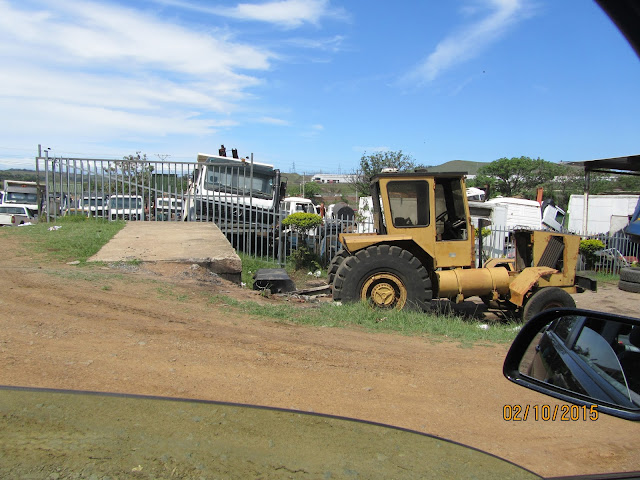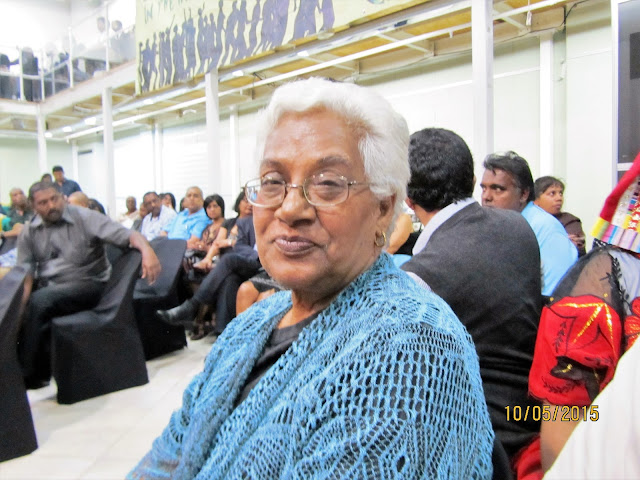Tuesday, January 24, 2017
OTTAWA RESIDENTS EXPRESS CONCERN ABOUT CONTINUED DEGENERATION
Concerned ratepayers and residents have once again drawn the attention of the Ethekwini Mayor, Ms Zandile Gumede, about the continued degeneration of the environment of their residential area.
They have pointed out that the degeneration is caused mainly by:
i). the litter and rubbish strewn on the main road running through the town;
ii). the numerous motor scrap yards on both sides of the main road;
iii). huge trucks driving through the residential Munn Road, Riverview Road, Maharaj Road and Kisson Road;
iv). a huge container depot at the far end of Riverview Road;
v). huge trucks parked in several properties in Riverview Road and at the far end of Kisson Road;
vi). the terrible smell and stink that emanates from the nearby municipal septic dam from across the river;
vii). the animal business that has been built on land reclaimed from the river near the Ottawa bridge; and
viii). the total destruction of the Ottawa river through unscrupulous truck owners dumping sand and rubbish into the river.
The residents pointed out that following their earlier written complaints and reports in the media, it has been noticed that the municipality has tried to pick up the litter and rubbish “but the litter bugs and other culprits continue with their destruction of the environment”.
The residents called on the municipality to immediately set up concrete bins at several spots on the main road and on the residential roads in order to encourage the “don’t care” people to use the bins for their litter and rubbish.
The residents added:
“It has also been noticed that one recently-opened panel beating shop at the corner of School Road and Munn Road has closed shop after concerns expressed to the municipality by our residents.
“But the main culprits who are destroying our residential roads and environment through their huge trucks are continuing unconcerned with their evil and illegal deeds.
“This huge truck (picture attached) was caught on camera by one of our residents driving through Munn Road to the container depot at the far end of Riverview Road. Huge trucks like this, ferrying containers, is not only dangerous to the residents in Munn and Riverview roads but also contributes to the destruction of the tarred roads and electricity cables and poles.
“We want to appeal to the municipal authorities to take immediate action to restore the residential nature of our areas. All trucking, container, and heavy industries must be moved out of our residential area immediately to industrial locations where they could operate without destroying the environment.
“:Heavy industries must be re-located and not allowed to operate in residential areas.
Please act immediately,” said the residents. Ends – January 24 2017
Wednesday, January 18, 2017
RAJAS PILLAY – OUR RICH HISTORY SERIES : THIS WAS AN ARTICLE WRITTEN ABOUT RAJAS PILLAY THREE YEARS. SHE PASSED AWAY TODAY DEC 29 2020. MAY HER SOUL REST IN PEACE
As we enter the 23rd year of our freedom, we want to recall the lives of scores of former anti-apartheid activists who played a vital role in some way or the other in the struggles for a free, non-racial and democratic South Africa. This series will be brought to you by veteran journalist, Subry Govender (Marimuthu Subramoney), who during his career spanning nearly five decades, has interviewed and profiled the lives of some of these political, social, educational and sports activists.
In our first instalment, Subry Govender profiles the life of 72-year-old Rajaluxmi Pillay of Reservoir Hills in Durban who spent 12 years in exile as a member of the political division of the ANC’s military wing, Umkhonto we Sizwe.
SHE BECAME AWARE OF RACISM AT AN EARLY AGE WHILE GROWING UP IN THE MINING TOWN OF KIMBERLEY
“My father was a member of the Natal Indian Congress and I have some letters from M D Naidoo and J N Singh asking him to attend meetings in Durban. He was also secretary to the Coloured Peoples’ Congress. So most of my political awareness at that time was coloured by the activities of my father.”
Rajaluxmi Pillay, who is well-known as Rajas to her comrades, friends and family members, was speaking about her entry into the anti-apartheid fold when I interviewed her in July 2009 just before she was honoured for her contributions to the struggles by the Durban-based Mahatma Gandhi Foundation.
Born in Pietermaritzburg in 1944 she became aware of the unjust political system when she was still a young girl while growing up in the diamond mining town of Kimberley.
Her parents moved to Kimberley when she was still a baby.
The discriminatory state of affairs at that time became clear to Rajas Pillay when she was denied entry to the Witwatersrand University in Johannesburg and the University of Cape Town to study law in the early 1960s.
She then went to London where spent three years from 1963 to 1966, completing her A levels. Here she came into contact with Dr Yusuf Dadoo and other South Africans in exile.
“Dr Dadoo used to use our flat for meetings with South African students and I came to know him very closely and others such as Essop and Aziz Pahad,” Ms Pillay told me.
CAME TO KNOW DR YUSUF DADOO VERY CLOSELY IN LONDON
“Although Dr Dadoo did not tell us directly what he was talking to the students about, it was clear that he was organising on behalf of the ANC. Dadoo and all others in exile were part of the Anti-Apartheid Movement,” she had said.
Heavily influenced by Dr Dadoo and the others, Rajas Pillay, accompanied by her younger brother and mother, returned to South Africa in 1966. They settled in Asherville in Durban.
She continued her studies at the University of Natal, where she came under the influence of activists of the calibre of Paul Devadas David, Phyllis Naidoo, Steve Biko, Rogers Ragavan and Ben Ngubane.
During the 1970s, Rajas Pillay came into contact with the ANC underground while working for the Game Discount Centre in West Street, Durban at that time.
WORKED FOR THE UNDERGROUND
“At the same time,” she said, “I became a field worker for a programme that the South African Council of Churches (SACC) was running to look after those who were affected by the oppressive actions of the apartheid people”.
“This gave me a good cover to make contact with people like George Naicker, Ebrahim Ismail Ebrahim, Mac Maharaj, Justin Khuzwayo, Shadrack Maphumulo, Phyllis Naidoo who left the country at some stage or the other, and some of the ladies that Phyllis used to be dealing with.
“There was a woman called Mynah. If I remember correctly her husband died on Robben Island and the regime did not inform her about his death.
“So this interaction of the people in the underground gave me more and more of an opening to go into the ANC.”
In 1979 Rajas Pillay was recruited as a member of Umkhonto we Sizwe and skipped the country to work for the ANC in Swaziland. Life here for the next 12 years was difficult and dangerous with the apartheid South
African Defence Force carrying out regular raids against ANC safe houses. Rajas Pillay was on the run most of the time.
“You know the regime used its security forces and agents to attack, kidnap and assassinate our people,” she recalled.
“There was fear all the time on the outside. The ANC headquarters in Lusaka, Zambia, told us that we must not leave the area and that we must survive somehow or the other.
LIVED ILLEGALLY IN SWAZILAND
“So the only option for us was to go underground and to live there illegally until headquarters gave us some direction as to what should happen. Then in 1985 two people came from headquarters to investigate our situation. They were Cassius Marge and Paul Dikeledi.
“But before they could leave the airport they were shot.”
Rajas Pillay was seriously affected by all the attacks, kidnappings and assassinations and she had to travel to Holland to seek medical treatment.
“Life in exile in Swaziland was tough and dangerous. This had a serious impact on a lot of us,” she said.
SERIOUSLY AFFECTED BY THE KILLINGS, KINDNAPPINGS AND ATTACKS OF ANC ACTIVISTS BY THE APARTHEID REGIME
She continued with her medical treatment after she returned to the country in 1991 when negotiations were in full swing between the ANC and the former National Party government.
Although she was receiving medical treatment, Rajas Pillay immediately returned to active politics by joining the ANC branch in Reservoir Hills in 1991. She was one of the senior people who helped to organise the people during the elections in 1994.
In July 2009, nearly 15 years into our non-racial and democratic order, Rajas Pillay was of the view that the country was proceeding in the right direction although there was still much more to be done.
“More needs to be done,” she said, “to bring about the social and economic upliftment of the majority of the people”.
“I believe more emphasis should be placed on education and the building of more schools for the many thousands of people who are on the sidelines of the new South Africa.
THE ANC MUST LISTEN TO THE PEOPLE
“The ANC must ensure that they attend to and listen to the people they are ruling. If they do this, then there will be nothing to fear,” she told me in that interview seven years ago.
Rajas Pillay said she was hopeful about the future because the younger generation were not fully aware of the evils of the apartheid past.
“The children today go to integrated schools where all the children sit with one another. They don’t see themselves in racial terms.
“They know no colour and that is where our future lies. I think if the class-room situation permeates in the hospitals, buses, trains, beaches and all that, then I think we are on the right track,” she had said.,
Rajas Pillay is just one of thousands of unsung heroes and heroines who have contributed to the struggles without making the headlines. It's hoped that they will not be forgotten. The honour bestowed by the Mahatma Gandhi Foundation on Rajas Pillay in 2009 is just the kind of gesture that would educate the post-1994 generations about the sacrifices made by many in our different communities for a non-racial, democratic and just society. Ends – subrygovender@gmail.com
Sunday, January 15, 2017
DASI AND DIVA SUBRAMONEY AT THE SA OPEN AT GLENDOWER GOLF COURSE IN JOHANNESBURG TO WATCH RORY MCILORY, WORLD NUMBER TWO, ON SUNDAY, JANUARY 15 2017
DASI AND DIVA SUBRAMONEY, WHO TOOK UP GOLF FROM A VERY EARLY AGE, WERE AT THE GLENDOWER GOLF COURSE IN JOHANNESBBURG TO WATCH THEIR HERO, RORY MCILORY, ON SUNDAY, JANUARY 15 2017.
THEIR NICK NAMES ARE TIGER WOODS AND VIJAY SINGH.
Saturday, January 14, 2017
(THE OTTAWA BRANCH OF THE S A RED CROSS SOCIETY RELAXING AT THE BEACH AFTER A DAY'S HARD WORK. FROM LEFT TO RIGHT(BACK): MR BARLEY, UNCLE WHO USED TO LIVE AT GEORGE SINGH'S FATHER'S HOUSE IN SCHOOL ROAD, CHOTOO WHO USED LIVE ON THE MAIN ROAD IN UPLANDS, DICKY MAHARAJ, AND MR PADAYCHEE FROM THE RED CROSS HEADQUARTERS. (FRONT): SUBRY, MR MOSES AND MR MANILALL.
BLUEBELLS HOUSE SPORTS TEAM AT THE OLD JHUGROO SCHOOL IN OTTAWA IN THE LATE 1950S.
(THIS IS A PICTURE TAKEN OF THE BLUEBELLS HOUSE SPORTS TEAM AT THE OLD JHUGROO STATE-AIDED SCHOOL IN OTTAWA IN THE LATE 1950S. SOME OF THE TEACHERS IN THE PICTURE ARE MR GOBINDER, MOON SUBRAYEN, AND D S MAHARAJ. THERE'S ANOTHER TEACHER WHO USED TO STAY IN MUNN ROAD NEAR OUR HOME. I DON'T RECALL HIS NAME. THE SCHOOL FRIENDS I CAN RECALL ARE JANAKI (LATER JAMES'S WIFE), PRITHIMA MAHARAJ, ISMAIL DHOOMA, KALIMUTHU, VALIATHAM, KANDASAMY'S SISTER, BARRY'S SISTER.)
Subscribe to:
Comments (Atom)







